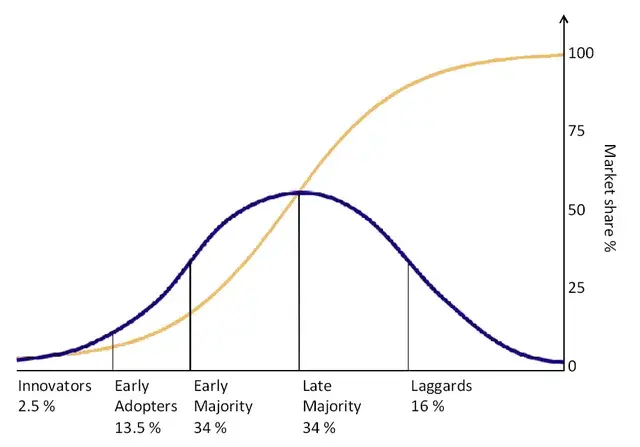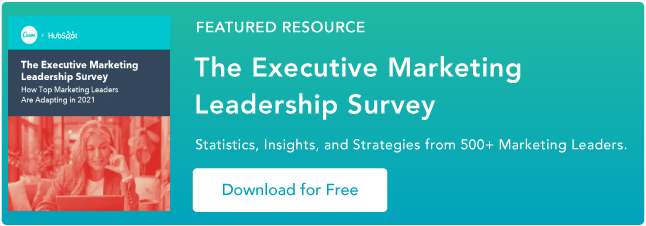Obviously, the rising popularity of the internet, social media, and smartphones played a huge role in taking digital marketing mainstream. But there was also a pivotal group of companies who drove its momentum: the early adopters of marketing technology.
What is an early adopter?
Early adopters are the first customers to adopt a new product or technology before the majority of the population does. They’re often called “lighthouse customers” because they serve as a beacon of light for the rest of the population to follow, which will take the technology or product mainstream.
Acquiring early adopters is a crucial step in the development and potential of an early-stage product or technology. Early adopters can provide a lot of helpful feedback about a product’s or technology’s pros and cons. They also inject these companies with revenue that funds the research and development needed to enhance the product or technology enough to gain widespread adoption.
Early adopters’ experience with and pending endorsement of a new product or technology is vital for determining whether or not the majority of the population will accept it. Their support and word-of-mouth marketing for a new product or technology can bolster its reputation and help the company acquire more customers.
But early adopters aren’t helping out ambitious start-ups for altruistic reasons -- this partnership is mutually beneficial and produces synergy. For instance, by providing companies with the vital feedback and revenues that can refine their product or technology and take it mainstream, early adopters get unique access to a potentially advantageous new product or technology.
Early adopters also receive first-class customer support, like a dedicated employee to help implement and run the product or technology, or generous discounts and terms and conditions, in exchange for dealing with the bugs that most early-stage products and technology have.
This mutually beneficial relationship doesn’t offset the risk that early adopters face for adopting a new product or technology, though. Customers might be able to get generous discounts, but the newly released product or technology is usually still expensive. It could also be incompatible with an early adopter’s products or the trend the technology is trying to leverage could die out.
For example, early adopters of content marketing software bet that content would be the future of marketing. Fortunately, they won that bet. But early adopters of artificial intelligence and virtual reality risk losing a lot of time and resources on a technology that could just be all hype.
Technology Adoption Curve
The term “early adopters” comes from the technology adoption curve, which was popularized by the 1962 book Diffusion of Innovations, written by Everett Rogers, a professor of communications at Ohio State University.
The technology adoption curve shows the acceptance process of a new product or technology, according to the demographics and psychographics of each group in a population. The curve has a normal distribution.

As you can see from the graphic, early adopters are the second group to adopt a new technology or product. The first group is called innovators, and the ones who adopt the technology after the early adopters are the early majority, late majority, and laggards, respectively.
Each group has unique characteristics, which influences their decision to adopt new technologies before or after they became mainstream. Here’s a general description of each group:
Innovators
- Youngest group of consumers or companies
- Most prosperous
- Most connected to outside sources and innovators
- Most risk-taking
- More educated
- Respected in the community
Early Adopters
- Younger groups of consumers or companies
- More prosperous
- Well connected with the community
- More progressive
- Most educated
- Thought leaders of the community -- opinions are held in high regard
Early Majority
- Older group of consumers or companies
- Above-average to average prosperity
- Connected with early adopters
- More conservative but open to new ideas
- Above average to average education
- Above average to average activity and influence in the community
Late Majority
- Older group of consumers or companies
- Average to below average prosperity
- Connected with the early majority
- Staunchly conservative -- approach innovation with a lot of skepticism and will only adopt technologies if they’re proven and the majority of the community has adopted the technology
- Average to below average education
- Average to below average influence in the community
Laggards
- Oldest group of consumers or companies
- Least prosperous
- Virtually no connection with the community
- Extremely conservative and traditional -- will adopt technology when its the only remaining option to complete a task
- Least educated
- Little to no influence in the community
From Hype to Reality
Early adopters played a key role in taking digital marketing technology from hype to reality. And if you’ve just developed a new product or technology, no matter what industry you’re trying to penetrate, recruiting a loyal group of early adopters could do the same for you too.
Customer Acquisition
.png?width=112&height=112&name=Image%20Hackathon%20%E2%80%93%20Vertical%20(39).png)



![2025 CPL and CAC Benchmarks [HubSpot Research]](https://53.fs1.hubspotusercontent-na1.net/hubfs/53/cost-per-lead-benchmark-1-20250227-9826989.webp)
